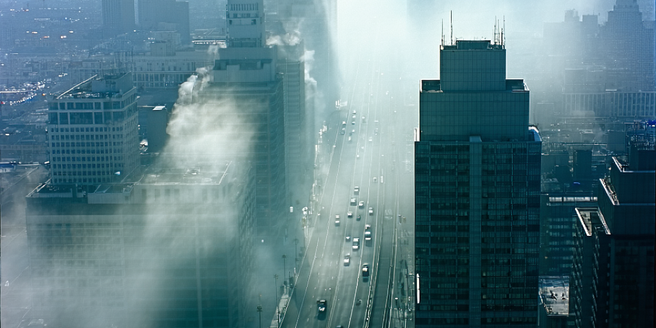
Understanding Urban Smog and Its Components
Urban smog, a visible and harmful form of air pollution, primarily consists of particulate matter, nitrogen oxides, volatile organic compounds, and ground-level ozone. These components originate from various sources like vehicle emissions, industrial activities, and chemical solvents. Particulate matter includes both fine and coarse particles that penetrate respiratory systems, posing health risks. Nitrogen oxides and volatile organic compounds react under sunlight, forming ground-level ozone, a key component of smog. Urban areas, with their high-density populations and energy consumption, exacerbate smog formation due to increased emissions. The dense smog not only affects visibility but also exacerbates respiratory illnesses and affects environmental systems. Understanding these components and their sources is crucial for developing effective strategies to combat urban smog and improve air quality in cities.
The Science Behind Weather and Pollution Interactions
The interaction between weather and pollution is complex, significantly affecting both local climates and air quality. Atmospheric conditions such as temperature, humidity, and wind patterns influence the dispersion and concentration of pollutants. For instance, calm and stable weather conditions can lead to the accumulation of pollutants, as they are not dispersed by winds. Temperature inversions, where a layer of warm air traps pollutants near the surface, can exacerbate this effect, leading to high smog levels. Conversely, wind and rain can help disperse and wash away pollutants, temporarily improving air quality. Understanding these interactions is crucial for predicting pollution episodes and implementing timely measures to protect public health. Moreover, increasing awareness about these dynamics helps in formulating effective environmental policies and response strategies.
Case Studies: Cities Experiencing Weather Changes
Several cities worldwide have experienced notable weather changes influenced by urban smog. Beijing, for instance, faces severe smog episodes, especially during winter, when temperature inversions are prevalent, trapping pollutants closer to the ground. Similarly, Los Angeles has long battled with its infamous photochemical smog, exacerbated by its geographic bowl shape that limits dispersion. In New Delhi, high vehicular emissions coupled with agricultural burning during certain seasons contribute to significant air quality degradation. Each city presents unique challenges due to varying topographies, industrial activities, and regulatory measures. Analyzing these case studies highlights the importance of context-specific approaches in tackling smog-related weather issues and emphasizes the need for tailored mitigation strategies that consider local environmental and socio-economic factors.
The Role of Temperature Inversions in Smog Formation
Temperature inversions occur when a layer of warm air sits above cooler air near the ground, preventing the normal upward movement of air. This meteorological phenomenon plays a crucial role in the formation of smog, as it traps pollutants close to the ground, leading to their accumulation. During an inversion, the air becomes stagnant, and pollutants emitted from vehicles, industries, and other sources do not disperse. This can result in high concentrations of smog, severely affecting air quality. Inversions are more common during winter, as long nighttime cooling of the earth creates the right conditions for warm air layers to form. Understanding the mechanics of temperature inversions is essential for predicting smog occurrences and implementing strategies to minimize their impact on urban air quality.
Impacts of Smog-Induced Weather Fluctuations on Health
Smog-induced weather fluctuations can have significant health impacts, particularly on vulnerable populations such as children, the elderly, and those with pre-existing respiratory conditions. High levels of smog not only degrade air quality but also contribute to respiratory and cardiovascular problems, increasing hospital admissions and premature mortality. The presence of particulate matter and ground-level ozone in smog can exacerbate asthma, bronchitis, and other chronic respiratory diseases. Additionally, prolonged exposure to polluted air can impair lung development in children and lead to reduced lung function in adults. Addressing the health impacts of smog requires a multipronged approach, including monitoring air quality, reducing emissions, and educating the public on reducing exposure during high pollution episodes, particularly for at-risk groups.
Strategies for Mitigating Smog and Stabilizing Weather
Efforts to mitigate smog and stabilize weather revolve around reducing emissions and implementing sustainable urban planning. Transitioning to cleaner energy sources, such as wind, solar, and electric vehicles, can significantly decrease the pollutants responsible for smog formation. Regulations limiting emissions from industrial activities and vehicles are crucial in this fight. Urban planning can also play a role by increasing green spaces, which improve air quality and provide shade that can reduce urban heat islands. Public awareness campaigns and air quality monitoring systems are vital for informing and protecting citizens, particularly during high pollution periods. Collaborative efforts at local, national, and international levels are essential to combat the transboundary nature of pollution and achieve long-term improvements in air quality and urban climate resilience.
